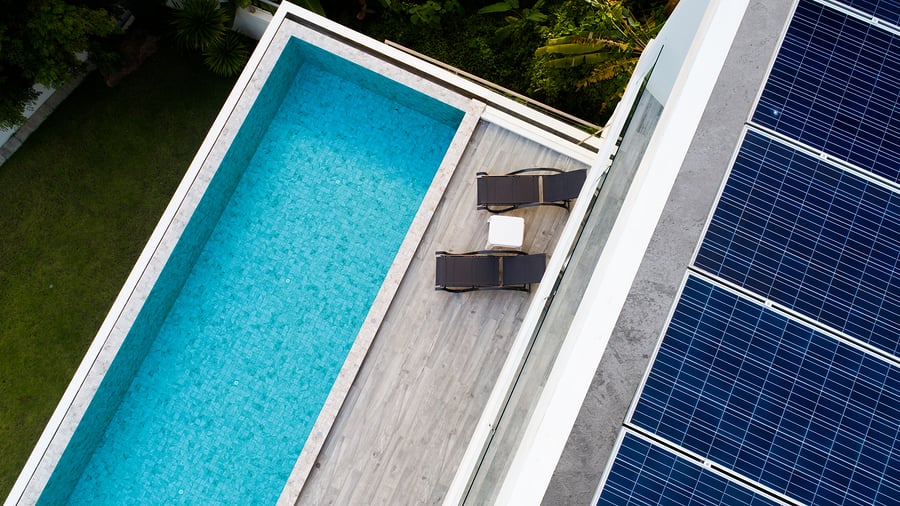Pool Heating Pump Systems: how to calculate heat loss and heater size
This Blog post goes in a bit of detail the complex calculations we provide for you with our instant online pool heater calculator.
This report is the gold standard of pool heater sizing and heating evaluation and will provide you with all you need to know to get your pool heated.
https://www.madimack.com.au/pool-heat-pump-calculator-2
Continuing from last weeks post where I explained how pool heat pumps being the most efficient way of heating a pool, I mention to speak to experts on how to calculate the heating requirement. This week I delve a little deeper into the technical aspects of pool heating pump Explaining COP, heat up times and kW required. So put your thinking cap on and continue reading, maybe you'll be an expert by the end.
What is a COP
What does COP stand for? You probably read this quite often on the sides of pool heat pumps and typical air conditioning systems. While conventional heaters only achieve efficiencies of about 75%, a heat pump delivers on average about 5 times the heat absorbed. Nearly 80% of the energy needed to heat the pool comes from the ambient air. With the newest inverter models this efficiency can be up to a COP of 15 depending on humidity and temperature.
A COP is in direct relationship with ambient air temperature and humidity because a heat pump extracts the heat from the air. Here is an Example of a COP chart taken directly from our testing facility of the Elite 11kW
of a COP chart taken directly from our testing facility of the Elite 11kW
For example, with a COP of 5 - 1kW of electricity consumed, creates 5kW of heat released into the pool.
In an example, if we warm our 40m³ pool by 10 ° C with a running time of 40 hours . For this we need a heat pump with an output of approx. 13.94 kW.
A heat pump should have about 1/5 lower power consumption = 13.94 ÷ 5 = 2.79 kW input
The relationship between the power supplied by the heat pump to the pool and the power it consumes is determined by means of the so-called COP factor (power coefficient). The higher the COP value of the pump, the more powerful it is and the lower your electricity bill.
Photovoltaic solar systems
are increasingly being installed in the private sector in order to achieve an even more cost-effective power supply. Anyone who has such a system can use a heat pump very economically.
How big does the heat pump for my pool have to be?
If you use your heat pump directly through your filter system, you should adjust the kW output to be slightly higher for lower run times but as an example here is a guide.
|
pool size |
kW power heat pump |
|
30 - 40m³ |
min 9 kW power |
|
40 - 60m³ |
min 12 kW power |
|
50 - 80m³ |
min 16 kW power |
The heat pump should be able to heat the water by approx. 0.20 - 0.25 degrees per hour. It takes 1.16 Wh to heat one litre of water one degree, which means 11.6 kWh for a 10m³ pool. In other words, one kilowatt hour heats 862 litre of water by one degree Celsius.
The following table shows how the heat pump is best designed:
|
volume |
Temperature increase per hour at a power of |
||||
|
m³ |
8 KW |
12 kW |
18 kW |
25 kW |
36 kW |
|
10 |
0.58 |
0.89 |
1.33 |
1.96 |
2.64 |
|
20 |
0.28 |
0.45 |
0.65 |
0.98 |
1.31 |
|
30 |
0.21 |
0.28 |
0.45 |
0.67 |
0.89 |
|
40 |
0.16 |
0.23 |
0.34 |
0.48 |
0.67 |
|
50 |
0.13 |
0.19 |
0.27 |
0.38 |
0.54 |
|
60 |
0.11 |
0.15 |
0.21 |
0.33 |
0.45 |
|
70 |
0.08 |
0.13 |
0.19 |
0.28 |
0.38 |
|
80 |
0.07 |
0.11 |
0.16 |
0.25 |
0.33 |
|
90 |
0.07 |
0.10 |
0.15 |
0.22 |
0.29 |
|
100 |
0.06 |
0.09 |
0.13 |
0.20 |
0.26 |
|
120 |
0.05 |
0.07 |
0.11 |
0.16 |
0.22 |
Choosing the right pool heat pump for your pool size?
The performance data is based on the following calculation basis
C x VX (T2 - T1)
P = -------------------------
h
P Performance of swimming pool heat pump
C heat storage coefficient of water = 4.186
V Pool volume
T2 Set temperature
T1 Start temperature
H Heat up time
The maximum heating time should be 4 hours per 1 ° C water temperature. This is calculated by the heat loss during the night being up to 2°C meaning it would take 8 hours to heat up to full temperature maintaining a constant temp throughout the season.
Example:
Say you have a swimming pool with 40m³ of water and an initial temperature of 18 ° C.
You want to heat the water to 28 ° C. The maximum heating time should be 4 hours per 1 ° C water temperature. Consequently, it takes 40 hours to heat up your 40m³ pool by 10 ° C.
This results in the following formula:
4.186 x 40 x (28 - 18)
P = ------------------------ = 52.33kW
40
What else do you need to know about a heat pump?
The choice of location is also very important because the heat pump needs very large amounts of air to function properly! For this, a suitable place for the fresh air must be found in most cases indoor operation does not work.
The heat pump itself is then integrated directly into the filter circuit, after the filter system and before the chlorinator if fitted.
High-quality heat pumps are equipped with corrosion-protected heat exchangers and can thus heat any swimming pool water, whether it is cared for with chlorine, bromine, ozone or chlorine-free products. The use for pools with sea water is also possible.
With all pools other factors including solar gains, wind factors and evaporation losses need to be taken into consideration. This article is to give a bit of insight on one way of sizing.

